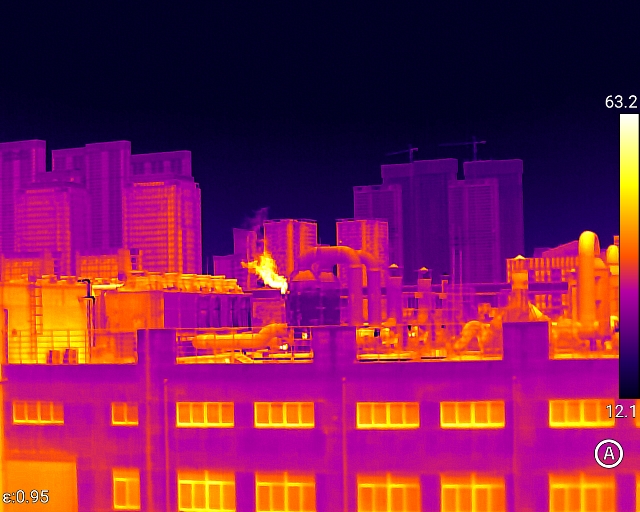Fields of Application
Handheld thermographic cameras have a wide range of potential applications. They can be used for security purposes, to detect hidden people or objects, for medical purposes, to diagnose circulation or nerve damage, or for industrial purposes, to find faults in electrical equipment or identify leaks in pipelines.
The automotive industry has also been utilizing this technology in recent years as infrared thermography can be used to detect problems with tires or brakes before they cause an accident.
How Does It Work?
A thermographic handheld camera measures the thermal radiation emitted by an object and converts it into an electrical signal. This signal is then processed to create a thermogram, effectively an image of the observed object.
Temperature determines how much thermal radiation an object emits. A hotter object will emit more infrared radiation. Therefore, measuring the infrared radiation emitted by an object makes it possible to determine its temperature.
The resolution of a thermographic handheld camera is determined by its number of infrared detectors. The more sensors, the higher the resolution and the more accurate the thermogram.
Best Thermographic Camera
It is essential to consider the resolution you need when choosing a thermographic camera. Higher resolutions will result in more accurate thermograms and more expensive ones.
Choosing a camera with a wide field of view is also essential. This will allow you to scan larger areas more quickly and easily.
Finally, review the features offered by different models of thermographic cameras. Some cameras have built-in displays, while others require a separate device, such as a laptop or smartphone. Some cameras also offer storage options for saving thermograms, which can be helpful if you need to refer back to them at a later date.
FLIR ONE
The FLIR ONE is the market's leading and most popular thermographic camera with 80 x 60 pixels resolution and a field of view of 45 degrees. It offers a range of features, including storage options and the ability to share thermograms via social media.
FLIR C2
If you need a more powerful thermographic camera, the FLIR C2 is an excellent option. It has a resolution of 160 x 120 pixels and a wide field of view of 54 degrees. It also offers onboard storage and the ability to share thermograms via email.
FLIR E4
For an industrial-grade thermographic camera, the FLIR E4 is perfect. It has a high resolution of 320 x 240 pixels and a field of view of 48 degrees. This offers onboard storage and the ability to export thermograms as PDFs.
Therm-App TH60
The Therm-App TH60 is a high-end thermographic camera with 640 x 480 pixels. It has a field of view of 33 degrees and offers the ability to share thermograms via social media. It also has an onboard storage option, saving up to 50 thermograms.
LaserIR Thermometer
The LaserIR Thermometer is a handheld thermographic camera with a resolution of 320 x 240 pixels. It has a field of view of 45 degrees and can share thermograms via email. It also provides an onboard storage option for saving up to 50 thermograms.
NanoIR Thermometer
The NanoIR Thermometer is a compact and lightweight thermographic camera with a resolution of 160 x 120 pixels. It has a field of view of 30 degrees and offers the ability to share thermograms via social media. It also offers an onboard storage option for saving up to 20 thermograms.
Thermographic Camera Price Range
Thermographic cameras can range in price from around $200 to $10,000. The price will also depend on the resolution, field of view, and features offered by the camera.
For occasional use, a lower-priced thermographic camera will suffice. However, if you require a high-resolution camera with a wide field of view and advanced features, you will need to invest in a more expensive model.
You can get one online or from your local hardware store.
Tips and Tricks
The thermographic camera might seem easy to handle, but first-time users still need time to get used to it.
Check out some tips and tricks for getting the most out of your thermographic camera:
● When taking a thermogram, ensure that the area you are scanning is in the center of the frame. This will allow you to capture the entire area in the thermogram.
● If you are scanning a large area, it is best to scan it in sections and then stitch the thermograms together.
● Hold the thermographic camera steady and move it slowly to ensure the image is clear. Always keep the camera at a consistent distance from the object you measured.
● You must also be aware of the limitations of thermography. For example, it cannot see through glass or metal, so you must consider this when selecting your viewing area. Thermographic cameras are light-sensitive, so avoid taking thermograms in direct sunlight.
● Finally, calibrate the thermographic camera regularly to ensure accurate readings.
Conclusion
Thermographic cameras are a valuable tool for detecting potential problems before they cause an accident or severe damage. Choosing a thermographic handheld camera with the correct resolution and features ensures you have the best chance of spotting a problem before it becomes serious.
Follow the tips and tricks mentioned above to maximize the thermographic camera's full potential, and don't forget to calibrate them to ensure accurate readings regularly. If you're ever in doubt, always consult a professional.













.svg)


(1).jpg)
(1).jpg)

